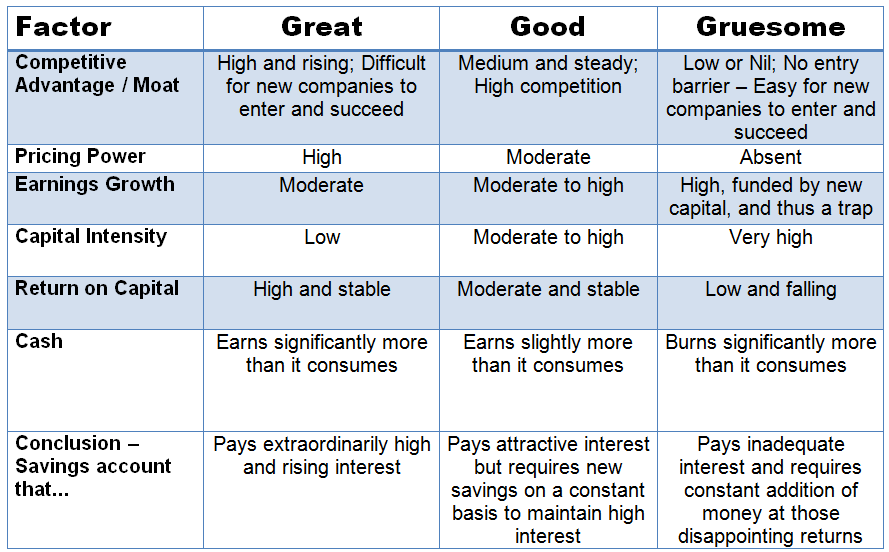“It’s a funny thing about life; if you refuse to accept anything but the best, you very often get it.” ~ W. Somerset Maugham – English dramatist & novelist (1874-1965)
For me, as a stock market investor, Maugham’s thought holds a great relevance when it comes to picking up businesses for investment.
Over the last 10 years of my experience as an investor, I have realized that whenever I’ve picked up a business with good economics and at the right price, I have made good amount of money on it in the long run. And whenever I’ve picked up a business with poor economics and at any price, I have lost money.
If you were to read a bit about Warren Buffett – one of the world’s richest men, and who became rich by identifying the right businesses to invest in and avoiding the bad ones – you would know that he puts businesses into three broad categories – Great, Good, and Gruesome.
He defines a great business as an “economic franchise”, and believes that it arises in a business that sells a product or service that:
- Is needed or desired (continuous and rising demand)
- Is thought by its customers to have no close substitute (customer goodwill is much better than accounting goodwill, and allows the value of the product to the purchaser, rather than its production cost, to be the major determinant of selling price)
- Is not subject to price regulation (price maker)
In other words, a great business is one that…
- Generates much more cash than it consumes.
- Has “moats” — a metaphor for the superiorities they possess that make life difficult for their competitors and helps the business earn high returns.
- Operates in a stable industry.
- Requires little incremental investment to grow.
- Has an ability to increase prices rather easily without fear of significant loss of either market share or unit volume
On the other hand, a “good” business is one that…
- Enjoys moderate but steady competitive advantage, which typically arises due to their size and thus economies of scale
- Requires good managements at the helm, that can execute the plans well to generate high return on rising invested capital
- Grows at a moderate to high rates, and thus
- Requires constant infusion of fresh capital
Finally, as Buffett explains, a “gruesome” business is one that…
- Consumes more cash than it generates.
- Has managers who boast of certainties and invincibility.
- Earns poor return on capital.
- Operates in an industry where it’s easy for new companies to enter and succeed.
- Operates in an unstable industry (maybe due to technological changes, or government regulations)
- Requires consistent infusion of new investment to grow.
- Doesn’t have an ability to increase prices.
- Isn’t able to accommodate large volume increases in business with only minor additional investment of capital.
Is Your Business Great, Good, or Gruesome?
To make it easier for you, I have tabulated the distinction between the great, good, and gruesome businesses as under…
Buffett says, “Time is the friend of the wonderful business, the enemy of the mediocre.”
So, please recheck your business very carefully.
Are you building a great, good, or a gruesome business?
About the Author: Vishal is the Chief Tribesman at Safal Niveshak, where he works with small investors to help them become smart, independent, and successful in their stock market investing and personal finance decisions.






Ranjeet Pratap Singh
This analysis does make sense for matured businesses -a good proxy could be publicly traded companies- however, I have sincere doubts that this makes much sense for early or growth stage companies.
Aside, it would be even more helpful if you can provide a couple of examples of the three kind of companies that you have mentioned 🙂